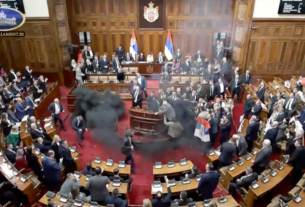Children in northern Thailand are suffering from a lack of medical care after the U.S. froze aid under President Trump’s administration. The funding cut has halted essential health services in remote villages, leaving families without access to doctors. Aid groups say the freeze has stopped programs that provided vaccines, medicine, and emergency treatment.
“You see children getting sick, and there is nothing we can do,” said a local health worker. Clinics that once offered free medical care have shut down, forcing families to travel long distances. Many parents cannot afford the cost of transportation, leaving their children without treatment.
The aid freeze has directly affected programs run by international organizations. These programs paid for doctors, nurses, and medical supplies in underserved areas. Without funding, local clinics have run out of basic medicine such as antibiotics and fever reducers.
A UNICEF report states that Thailand’s rural areas already face a shortage of medical professionals. The aid freeze has made the situation worse, putting more children at risk. Officials warn that preventable diseases such as pneumonia and measles could spread rapidly.
Many families in these areas live below the poverty line. They rely on free or low-cost medical services to keep their children healthy. The lack of aid means that even minor illnesses could turn deadly without proper treatment.
The U.S. government has defended the decision, saying the aid freeze aligns with new foreign policy goals. Officials argue that funds should be directed to countries that support U.S. interests. Critics say the cuts hurt vulnerable communities the most, especially in rural areas.
“Doctors used to visit our village every month,” said a mother from a remote community. She now has to walk several hours to reach the nearest hospital. Many parents share the same struggle, with some unable to make the trip at all.
Thailand has a strong healthcare system in its cities, but rural communities face major challenges. The government has programs to send doctors to these areas, but they are not enough. The aid freeze has removed a critical source of funding that supplemented these efforts.
Local organizations are looking for alternative sources of funding. Some groups have reached out to private donors, but the donations are not enough to cover the gap. Many health workers are volunteering their time, but they lack the resources to provide full care.
A recent survey found that over 60% of rural clinics in the affected areas have either closed or reduced services. The situation has led to an increase in cases of malnutrition and preventable diseases. Some children with chronic conditions have been left without treatment.
International health organizations have called for the aid freeze to be lifted. They warn that the long-term impact could be severe if healthcare access does not improve. The Thai government has urged other countries to step in, but support has been slow.
Doctors and nurses continue to work under difficult conditions with limited supplies. Some have turned to crowdfunding to keep essential services running. Many believe that unless funding is restored, the crisis will only deepen.
The aid freeze has affected other programs, including education and food assistance. Children who do not receive proper healthcare struggle to stay in school. The combination of poverty and lack of medical care creates long-term challenges for these communities.
Health experts warn that without intervention, the situation could worsen. Disease outbreaks, higher infant mortality rates, and long-term health issues could become more common. Aid groups continue to push for action, but progress has been slow.
For many families, the future remains uncertain. Parents hope for the return of doctors and medicine, but there is no clear timeline. Until then, children in these villages are left without the care they desperately need.




